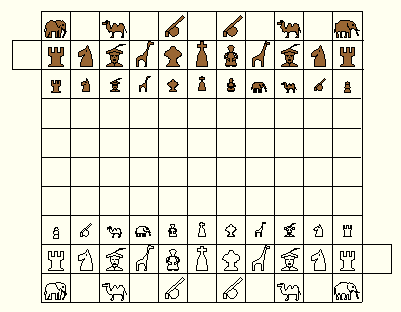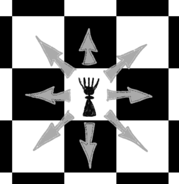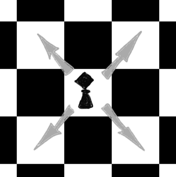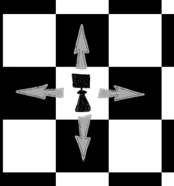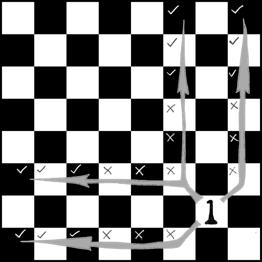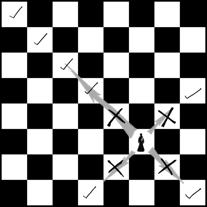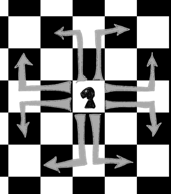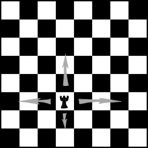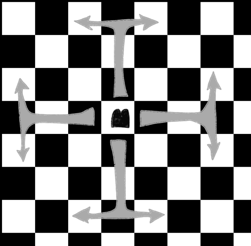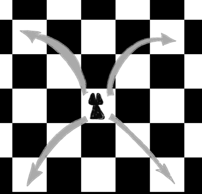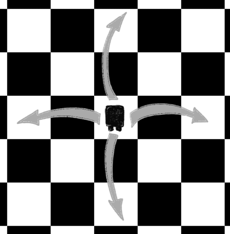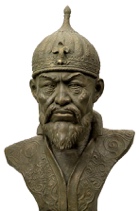
Tamerlane
Chess: Rules and Information 
During the reign of Timur Lenk, also called Tamerlane (1336 - 1405), Timur Chess was played often in Persia. The game is a large variant of Shatranj, the orthodox chess-game of that period. As a consequence, the game was also called Shatranj Kamil (perfect chess) or Shatranj Al-Kabir (large chess).
This game - also called Timur's chess or Tamerlane Chess - is possibly the most complex variant of Shatranj ever made. It is included in the family called Shatranj Kamil and Shatranj al-Kabir but easily stands out on its own. It was very popular in Persia and other lands and was said to have been invented by the chess master Timur himself but the truth behind that is unknown.
Most versions of Shatranj - and most other chess around the world - have identical pawns. However, Tamerlane does not. Each piece is unique and is called a Piyade. Ten of the eleven Piyade belonged to one of the greater pieces on the ranks behind it and a pawn existed for each type - including the Shah. The final Piyade was the Pawn of Pawns. Promotion for nine of the Piyade was straightforward; when they reached the final rank, they promoted to the piece they were represented of. The exceptions were the Shah's pawn and the Pawn of Pawns.
It would seem that the Shah has many means of escape and the game could be lengthy to complete. However, the Shah's Pawn and Pawn of Pawn were prime targets to prevent reaching the final rank and promoting so the Shah most likely usually only had one escape option - that of the one-time exchange with an allied piece.
The rest of the rules were almost the same as in Shatranj. The only exception might have been the bare king rule; it is not known if it was used or not so that should be up to the individual players if they choose to include it. A checkmate (of all kings of one side) or a stalemate were definitely considered wins.
The game was mentioned in Murray's History of Chess, and discussed in more detail, with sample game, in the book of Gollon.
The pieces are notable for being rather weak compared to Queen's chess, missing the aforementioned eponymous piece. There is much to be said for solid chess tactics, but the pieces such as the Zarafah and reimagined Shah (King) bring a fresh perspective to this eternal game.
See
also: -
John
Gollon’s Chess Variants: https://amzn.to/3xFPR2h -
A
History of Chess: Murray, 1913 Edition: https://amzn.to/3dAhdQl -
The History of Chess (Forbes, 1860): https://amzn.to/3BUITIZ -
3d Printed Pieces:
shop.timurchess.online The Board The
game is played on an uncheckered (or checkered) board of 112 squares: a board with
ten rows, eleven columns, plus two extra squares, one left of the
ninth row, and one right of the second row.
These
two extra fields are called the citadels and play a special role in
the game. Each
player has the following pieces: a king, a vizir, a general, two
giraffes, two pickets, two knights, two rooks, two elephants, two
camels, two war engines, and eleven pawns. Pawns are of special
types: there is a pawn of kings, pawn of vizirs, pawn of generals,
etc. Additionally, there is the pawn of pawns.
The
type of pawn affects what happens when the pawn promotes; this is
quite special for the pawn of pawns, see below. Opening
setup Three
different opening setups were used. We give one of them here; for the
others, which are not too different, see e.g. Gollon's description of
the game.
The
small pieces at the top rows of the players are pawns, modelled as a
small copy of the type they belong to. White's
top row contains from left to right: pawn of pawns, pawn of war
engines, pawn of camels, pawn of elephants, pawn of generals, pawn of
kings, pawn of vizirs, pawn of giraffes, pawn of pickets, pawn of
knights, pawn of rooks. The second row of white contains from left to
right: rook, knight, picket, giraffe, general, king, vizir, giraffe,
picket, knight, rook. The bottom row contains from left to right:
elephant, space, camel, space, war machine, space, war machine,
space, camel, space, elephant. Movement
of pieces The
king
(shah) (★) moves as a usual king. A
single square in any direction, diagonal or orthogonal. The
general
(ferz
or ferzan) (F)
moves one square diagonal.
The
vizir
(chancellor
or wazir) (V)
moves one square orthogonal,
aka. “straight”
(horizontal or vertical). The
giraffe
(zarafah) (G)
moves one diagonal and then after that at least three straight. For
instance,
when
on a1, the giraffe can move to b5, b6, b7, etc., provided that all
passed squares (b2, b3, b4, ...) are empty. The
picket
(bishop) (B)
moves as a modern bishop, except that it always must move at least
two squares. The
knight (K)
moves as a modern knight. The
rook (R)
moves as a modern rook. The
camel
(jamal) (C)
has a kind of stretched knights move: it jumps one diagonally and two
straight, so e.g. from a1 to b4 and d2; as a knight it is not
obstructed by pieces standing on passed squares. The
elephant
(pils) (E)
jumps two squares diagonally: it goes exactly two squares diagonally,
but is not obstructed by a piece on the square in between. The
war
engine (dabbabah) (W)
jumps straight (horizontally or vertically) two squares. Again, it is
not obstructed by a piece on the jumped square; thus the war engine
has the “straight” (orthogonal)
variant of the elephants move. The
pawns
move as modern pawns, except that they have no initial double step.
See below for the promotion rule. Promotion
rules
The promotion rules are simple for almost all pawns, with two exceptions: the pawn of kings and the pawn of pawns (PP) . All other pieces, when reaching the last rank,promote to the type of piece they belong: the pawn of rooks promotes to a rook, and the pawn of camels promotes to a camel, etc.
When the Shah's pawn promotes it becomes a Shahzada - a Prince. This piece had the same moves as the Shah but could place itself in check. The opponent Shahzadawould need to be taken as well as the Shah to win the game. The Shah is allowed to be placed in check or left in check if the Shahzada is on the board. If the Shah was captured, it could exchange itself with the Shahzada.
The Pawn of Pawns is even more intricate. When this piece reaches the final rank for the first time, it must remain there; it cannot be captured while there and can only move under two limited conditions. If a square exists where a pawn at that location would be attacking another piece that cannot escape capture, the player may put the Pawn of Pawns on that square. The other condition happens when a place exists where a pawn gives a fork - meaning it would be attacking two pieces at the same time. If a piece already exists on that square - either allied or hostile - it is removed if the Piyade is placed there except for a Shah. After this, the Pawn of Pawns moves as normal until it reaches the final rank a second time. Then it is placed on the starting square of the Shah's pawn (F3 or F8 in the above starting arrangement). If it can reach the final rank a third time, it promotes to a Sha Masnu'A - an Adventitious King. The Sha Masnu'A moves like the Shah and needs to be captured before the game can be won. It also lets the Shah be allowed to be placed in check. Again, if the Shah was captured, it could exchange itself with the Sha Masnu'A. Citadels When
a player is able to move his king into the citadel of his opponent,
the game is drawn. A player may not move any other piece in the
citadel of his opponent and may only move his adventitious king in
his own citadel. This prevents the opponent from occupying the
citadel. he citadels cannot be covered by pieces such as a rook or bishop to prevent the shah from entering, ie. the three squares providing ingress to the citadels can be covered, but not the special citadel space itself. For instance an opposing rook covering the 9 and 2 ranks do not prevent the enemy king from entering the citadel from a diagonal ingress point (K1 or K3, and A8 or A10 respectively.) Other rules If
a player, not owning a prince or adventitious king, is mated, he
loses the game. If
a player is stalemated, he loses the game, unlike in "normal", aka Queen's chess. Play
this game with or without a “bare king” rule: Gollon assumes
there was not such a rule. *Written
by Hans Bodlaender, January 1996. https://www.chessvariants.com/historic.dir/tamerlane.html Full
Tamerlane chess In
a few manuscripts the empty squares on the back rank are filled with
new types of pieces. The Revealer(♡), The Lion/Assad(L) and The Bull/Thaur(T). The following setup appears in ms 7322 (British
Museum):
Elephant
(a1), Lion (b1), Knight (c1), Bull (d1), War Engine (e1), Revealer
(f1), War Engine (g1), Bull (h1), Camel (i1), Lion (j1), Elephant
(k1) Rook
(a2), Knight (b2), Picket (c2), Giraffe (d2), General (e2), King
(f2), Sea Monster (g2), Giraffe (h2), Picket (i2), Knight (j2), Rook
(k2) Pawn
of Pawns (a3), Pawn of Knights (b3), Pawn of Camels (c3), Pawn of
War Engines (d3), Pawn of Generals (e3), Pawn of Kings (f3), Pawn of
Sea Monsters (g3), Pawn of Giraffes (h3), Pawn of Pickets (i3), Pawn
of Lions (j3), Pawn of Rooks (k3) Pawn
of Bulls (c4), Pawn of Revealers (f4), Pawn of Elephants (i4). Black's
1st, 2nd, and 3rd rows are arranged following rotation symmetry as in
the standard setup: but the 4th row is arranged
with reflection symmetry,
so that the pawns of bulls face each other. Note that there is only
one camel, but three knights (one knight replaces the missing camel***).
A sea monster replaces the vizier. The
manuscript does not offer guidance as to how the extra pieces
move. Duncan
Forbes suggested in 1860 that the lion should combine the moves of
rook and giraffe; the bull should combine the moves of picket and
giraffe; and the revealer should combine the moves of picket and
rook. (He gave the picket the move of the modern bishop, thus making
the revealer identical to the modern queen.) Jean-Louis Cazaux
suggested in 2012 instead that the extra pieces were simple leapers:
the lion a (3,0)-leaper
the bull a (3,2)-leaper,
and the revealer a (3,3)-leaper. Both assume that the sea monster is
identical to the vizier: a (1,0)-leaper. ** **
Wikipedia
Entry: https://en.wikipedia.org/wiki/Tamerlane_chess Youtube -
The next level of chess | Tamerlane Chess
https://www.youtube.com/watch?v=SEZ0jIgF8yk -
Tamerlane Chess Part 1 (sample game)
https://www.youtube.com/watch?v=eekErvVYZLg -
Tamerlane Chess Part 2 (sample game)
https://www.youtube.com/watch?v=SMUbX4vJseg -
Tamerlane Chess Part 3 (sample game)
https://www.youtube.com/watch?v=WRdUfTVKJBA -
Tamerlane Chess: Piece Values, Tactics, and Clarifications
https://www.youtube.com/watch?v=WA-p3OO-bRs Links -
Play Timur Chess Online (Java required):
chessvariants.com
